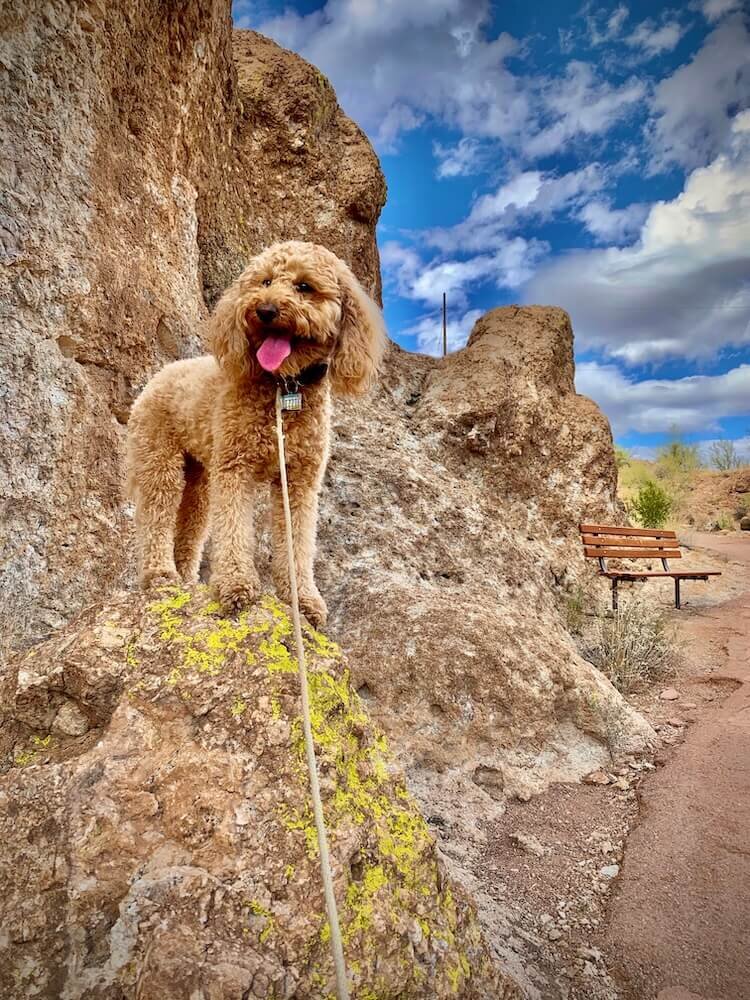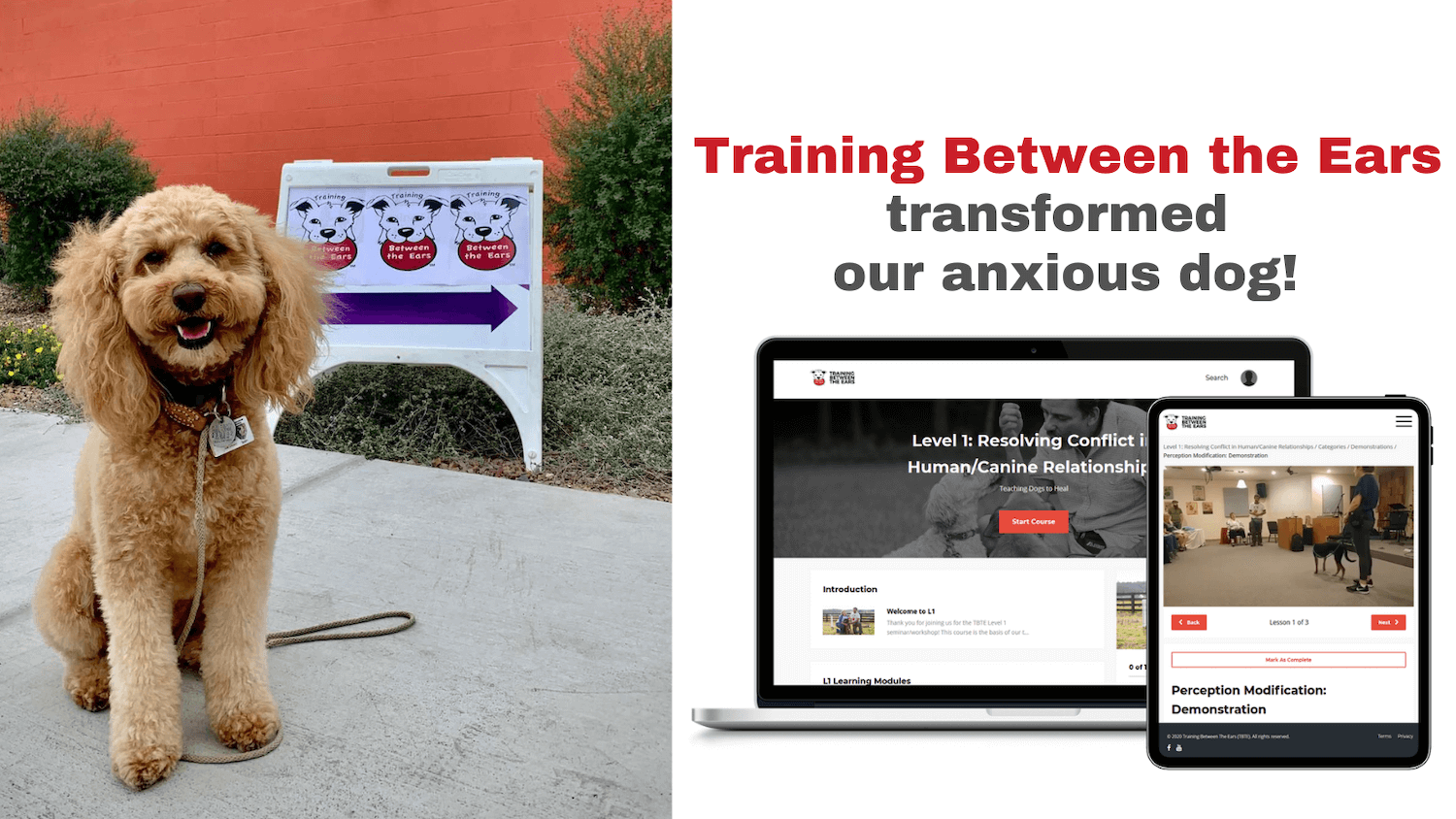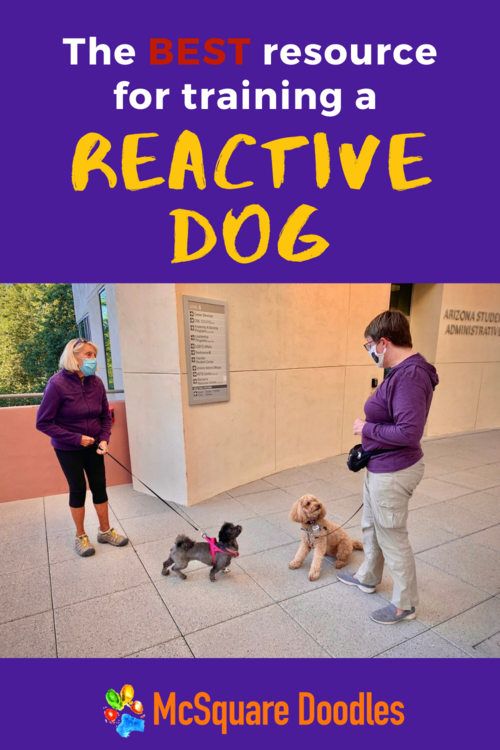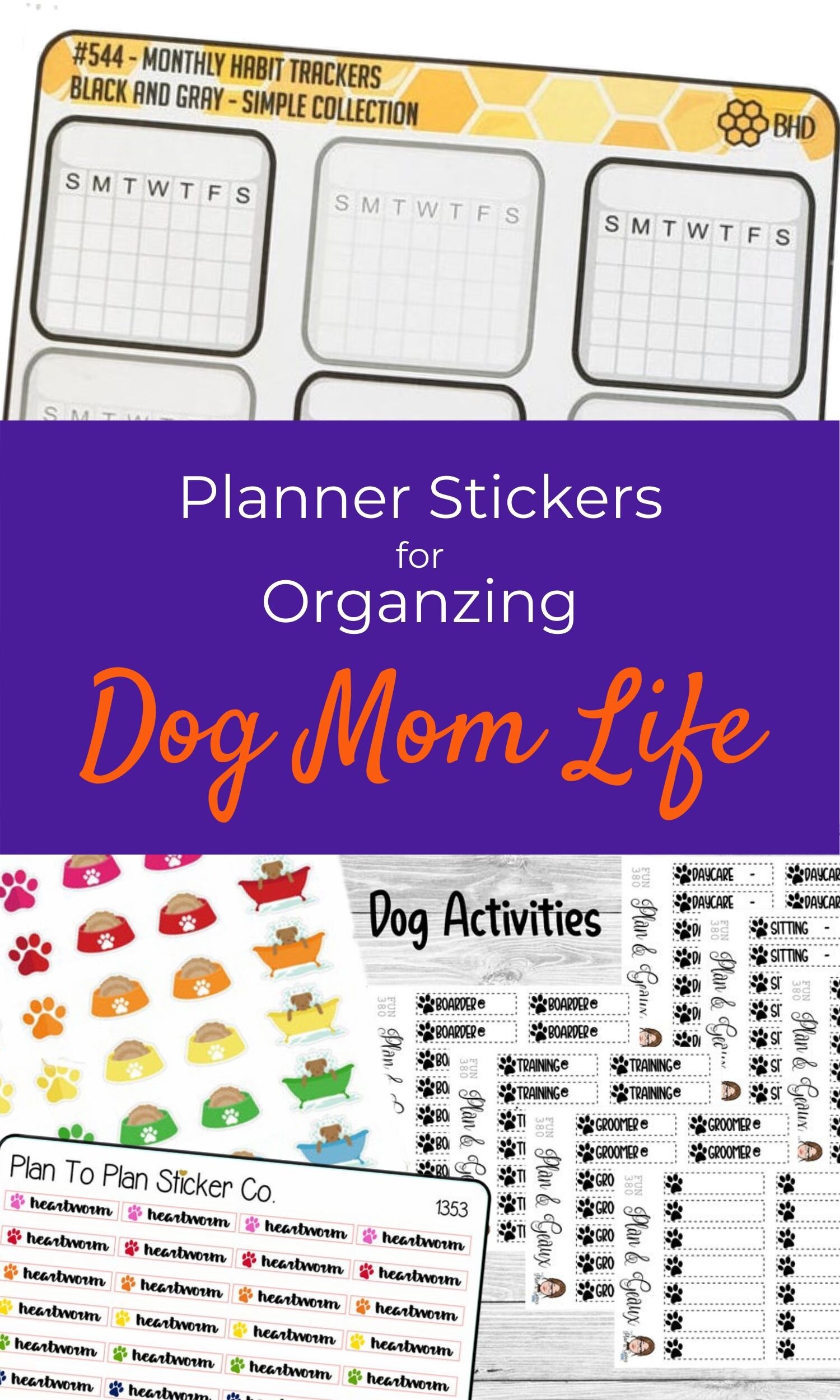Helping Our Reactive Dog Find Calm
/Lizzie has always been my sassy Australian Labradoodle who’s more vocal than her mellow big brother Bernie. But when her reactivity spiraled out of control, I found myself wondering, “Can a reactive dog be cured?”
What I’ve learned is that living with a reactive dog is tough. There’s no simple solution. No magical potion or treat will transform your dog.
But with dedication to your dog and proactive training, you can help your reactive dog find calm. Your reactive dog will make progress and life will gradually get easier.
This post may contain affiliate links, which means at no additional cost to you, I may earn a small commission if you click through and purchase something. Please see my Affiliate Link Disclosure policy for more details.
What is a reactive dog?
Reactive dogs overreact to environmental stimulus.
The stimuli can vary. Why they overreact can vary too. While some dogs may be aggressive or high energy, many are overreacting out of fear. Some dogs may be afraid of other dogs. Other reactive dogs may fear children, loud noises, bicycles, skate boards, or a host of other challenging provocations.
Reactive dog behavior looks like barking and lunging at whatever makes them anxious.
How did Lizzie’s dog reactivity begin?
I cannot tell you how many times I’ve considered this question, wondering if there was something I could have done differently.
The best answer I’ve found for Lizzie is that for a tiny dog she does everything big!
She approaches everything with gusto. She’s endlessly enthusiastic, but that frenzy pairs with fear.
As an 8-week old puppy, she was shaking when Matthew and I picked her up at the breeder.
We could tell that the whole process of bringing her home overwhelmed her.
As scared as she was, her cheekiness was still there.
As I prepared her dinner that night, she started demand barking. I calmly put all of her food and dishes away, which puzzled her.
After a few minutes had gone by, I tried preparing her dinner again.
She barked.
I walked away.
On the third attempt, Lizzie remained quiet.
People think I’m kidding with this story, but she really did get it that quickly. She tried demand barking for breakfast. I put everything away and walked away. Lizzie remembered the lesson from the night before because when I started making breakfast again, she sat quietly watching me.
Her dog reactivity develops
During puppy obedience class, she would bark at the baby gate that would separate her and another small puppy from the larger puppy breeds. I didn’t think much of it at the time, but barking at barriers became a thing for her.
We enrolled in Super Puppy Fitness Class at A Loyal Companion. Every week as we entered the dog gym, I would have to distract Lizzie, and calm her down because she would start barking.
As we approached her first birthday, Lizzie’s barking showed no sign of stopping.
On walks, I could see that she was more and more aware of other dogs and overreacting to their presence, so I started walking farther away from people, especially avoiding people with dogs.
Trying to figure out how to train a reactive dog
During the summer of 2018, we took Basic Obedience with Ruff House. When we trained indoors, Lizzie barked more than when she was outside, but none of her barking prevented her from learning.
When I would ask her to sit, stay, recall, go to place, and walk on a loose leash, she could perform a majority of the tasks well with little ruff-ruff-ruff.
Lizzie loves working and learning, so we spent a lot of time practicing. The video below includes footage from one of our training sessions right before graduation night.
After Puppy Obedience, I started taking Lizzie to our trainer’s drop-in park obedience class. Park Class definitely helped me and Lizzie, but I was constantly adjusting our distance from other participants because Lizzie would start barking.
Various factors could affect her anxiety level: the number of dogs, the energy of the other dogs, other sights and sounds she might deem strange, which was hard to predict.
We could see a man wearing a hat and sunglasses and Lizzie would ignore him, but if another man wearing a different hat and sunglasses appeared, she could decide that something about this guy was suspicious and barking would ensue.
During her adolescence, we kept training.
I tried paying attention to what Lizzie was looking at so that when she quietly would look at another dog or child, I would mark with an enthusiastic "Yes!" and then feed her a treat. But it seemed like no matter how hard I tried to keep up with her, she was always finding something new to look at and freak out over.
Also, my timing was terrible. I cannot tell you how many times our trainer Crystal would look at me and say, “Now. Yes and feed!” and my reaction was “Huh?”
Crystal also tried to teach me how to use an intermediate bridge, which is a way of communicating with Lizzie that she’s making a good choice. It allows Lizzie to stay in good choice mode for 2-3 seconds before I mark with “Yes!” and feed her a treat.
My fixed mindset was that I was already the crazy dog lady walking around with a dog who barks at everything. I’m not adding a repetitive sound, the intermediate bridge, and getting even weirder looks from people.
Side note: As far as I’m concerned amazing dog trainers are the most patient people ever. I was seriously struggling with Lizzie, but Crystal never gave up on us.
Increasingly, I dreaded taking walks with my dogs.
Lizzie's barking combined with occasional lunging was stressful.
I couldn't enjoy just being with my dogs. I had to spend all my time constantly scanning our environment for any sight that might set Lizzie off.
Sometimes I could evade oncoming challenges and other times stimuli would just pop around a corner and surprise all of us.
By the summer of 2019, I was at my wit's end. I was really scared that I was approaching the point where I might think “I hate my reactive dog” and I didn’t ever want to get to that place.
Matthew and I decided that we needed to schedule Lizzie with Crystal for a board-and-train to address her reactivity. Thankfully, Crystal had openings in the fall.
Interestingly, in August 2019, Matthew and I took a short vacation, so Bernie and Lizzie stayed at the Tucson Adventure Dog Ranch.
Unlike traditional kennels, Tucson Adventure Dog Ranch is a home-style, cage-free dog boarding facility where the schedule of activities keeps dogs engaged and happy.
Running around Thom’s fenced property with other dogs didn’t bother Lizzie at all. Thom reported that both dogs did really well. They stuck together, but participated in all the activities.
Seeing all the photos Thom would share every night of Bernie and Lizzie having fun with a bunch of other dogs of all sizes and breeds gave me hope. On Thom’s spacious property, Lizzie wasn’t scared. She was able to enjoy dog activities with other dogs.
Lizzie’s transformational board-and-train
Normally, I would not be a proponent of board-and-train programs. Too many people outsource their dog’s training thinking as long as the dog learns what to do, they’ll transfer those skills to their home environment without any help from them, the dog’s owners.
However, Matthew and I realized that I had reached my limit on being able to help Lizzie overcome her reactivity.
While I understood what I should be doing to support Lizzie, and Crystal had coached me (extensively) on how to mark and reward Lizzie for calmly looking at other dogs, my execution in the real world was terrible.
Plus I still refused to use the intermediate bridge. Crystal Blaker, I really don’t know how you put up with me.
Lizzie needed, and deserved, the precision communication of a professional dog trainer, so she spent four weeks with Crystal and her family learning how to remain calm around other dogs in a variety of settings.
Since Lizzie knew so much basic obedience, Crystal could really focus on helping Lizzie overcome her reactivity. Lizzie was so well-behaved she was even allowed on Crystal’s couch, which is quite a privilege in the Blaker home.
Crystal took Lizzie to different parks and stores using Training Between the Ears strategies, including the intermediate bridge, to help Lizzie understand when her behavior was desirable. Simultaneously, Crystal used the TBTE relaxation triad in her home with Lizzie to relieve dog anxiety.
We’d regularly receive “proof of life” photos from Crystal showing Lizzie enjoying all of her field trips, like when they went to PetSmart.
But even better, we got multiple videos of Crystal narrating what she was doing with Lizzie while out on walks.
Crystal would point out specific body language on Lizzie and then demonstrate what to do to help Lizzie remain calm.
She would also explain which TBTE strategies she was implementing as she used them.
I could ask questions about why she made one choice over another, and Crystal would always elaborate.
Crystal went to different parks and would try to film specific behaviors so that she could describe how I should manage those behaviors.
I would watch the videos multiple times until I could identify the same body language signals that Crystal was describing.
Crystal and I met a few times for me to practice the TBTE techniques with Lizzie.
The first meeting was at the halfway mark of the board-and-train, the second time was on the last day of the program, and then we met two weeks later for follow up questions.
Embracing the Training Between the Ears system
My homework was to take Lizzie on several solo walks per week and continue using these Training Between the Ears strategies.
Since Lizzie had an intensive foundation training with TBTE with someone who knew what they were doing, she was much more forgiving of my bumbling timing, and me struggling to remember which strategy to use when.
By studying the videos from Crystal and carefully watching Lizzie on our solo walks, I gradually got better and better at supporting Lizzie with an intermediate bridge and marking calm behavior with a “Yes!” and food reward.
Even if it took me a few seconds to get the treat out, Lizzie would focus on me, usually sitting in front of me patiently waiting for her reward. Having a reactive dog who’s super smart has helped me tremendously.
Leveling up to TBTE novice
Crystal had encouraged me several times to attend the Training Between the Ears Level 1: Resolving Conflict in Human-Canine Relationships seminar before, so in November 2019, Lizzie and I spent three days learning more about this proven system.
Talk about a game changer!
I remember listening to Mark McCabe explain how to use an intermediate bridge, terminal bridge, conditioned relaxation, behavioral down, and more to solve various behavior problems, and in between my note taking, I was thinking and overthinking.
I would raise my hand, and basically repeat back what I had just learned expressing shock that if I did X consistently, then over time I could see different behavior from my dog. And Mark would smile, confirm that I had heard him correctly, and then usually expand or elaborate on the original point.
Mark is a talker, which is fine by me. As an overthinker who likes to ponder, I frequently talk through my process. Every dog is different, and Mark not only recognizes that, he embraces it. He wants dog trainers and handlers to learn how to use the tools of TBTE and adjust their use to the needs of each individual dog, including making changes as the dog progresses.
After the three-day seminar, my confidence in using TBTE techniques was bolstered and Lizzie continued to do well.
for solving behavioral problems for your anxious dog?
Find out more about the online course:
L1 Resolving Conflict in Human-Canine Relationships
Lizzie and I tackle more training with TBTE support
Crystal suggested that Lizzie skip Intermediate Obedience Class and join her 8-week Advanced Obedience Class that met at a new location each week to practice skills with different distractions.
There would be a few minutes at the beginning of each class when Lizzie would get nervous or excited. We’d be at a new store or park, she’d see other dogs, and start barking as we would approach the group. I would use a few different TBTE techniques, and she’d calm down.
Lizzie was the only small dog in the class, but her ability to concentrate on the work at hand impressed me week after week.
Then I signed her up for Intermediate Agility, and that environment was equally challenging for her. We always met at Crystal’s practice agility field at her house, so the environment stayed the same, but several of the dogs were high energy like Lizzie. They loved zipping in, over, and around all the obstacles.
But I stuck with the TBTE techniques and we worked through every scenario.
Then Matthew and I decided to take Intermediate Obedience with both dogs in February 2020. Matthew handled Bernie while I worked with Lizzie. Again, practicing around several other dogs was so good for her and me. We both had to figure out how to manage different situations.
Crystal and I had a conversation about how taking Lizzie to more and more places with dogs was good for her. Lizzie needed to generalize that other dogs walking around don’t pose a threat to her.
I also continued numerous solo walks with Lizzie every week until the pandemic hit and Arizona shut down in March 2020. I decided to mitigate my exposure by walking both dogs together.
Dog training changes during the pandemic
The pandemic hit many hard, including small dog training businesses. Taking classes was no longer an option, but I knew that classes provided the ideal environment for Lizzie.
Anyone who attends classes with their dog is someone who cares deeply about their dog. They want a better relationship with their best friend, and those are the kind of dog owners who I know will understand reactivity.
Sure, they may not understand reactivity at first, but a good trainer will be all over explaining what everyone should do or not do. They’ll explain that Lizzie is overly excited or scared, depending on the situation, and that her barking doesn’t mean she wants to eat their dog.
Enter innovative dog classes for the pandemic: Pack Walks
As Arizona opened up over the summer, I was monitoring the websites of a few trainers. Bernie and I had attended numerous drop-in therapy dog classes at The Complete Canine’s studio and we were missing that training environment.
And then in the early summer, the announcement. The Complete Canine was restarting their outdoor Pack Walks.
On Tuesday mornings, we’d drive over to Reid Park to meet Rachel. On Thursdays, we’d meet Jeremy or Jenny at the University of Arizona.
Matthew and Bernie would pair up, so I could concentrate on Lizzie.
Some dogs would show up regularly, while other dogs would show up a few times only. The mixture of different dogs every week kept all of us on our toes. Plus there was always all the other people walking around the park or campus with their dogs.
Finding the best harness for walking both dogs
During one of the Pack Walks, Rachel suggested that we try a front-clip harness for both dogs. We had been using slip-leads, mainly because Bernie is not a fan of harnesses, and we’ve never liked the idea of clipping a leash to a collar that could breakaway.
It’s simple design makes it possible for me to unclip just one of the buckles to put it on or take it off the pups. Plus it’s been an incredibly helpful tool for Lizzie.
Lizzie likes walking out front so much that Rachel nicknamed her Trailblazer.
With a front-clip harness, Lizzie can walk out front without pulling. Generally, Lizzie didn’t pull with the slip lead on most walks.
But when we’d go hiking, she wanted to zoom ahead. All the time. With this front-clip harness, she’s content to walk next to me or just a bit out front. This change in equipment has definitely helped Lizzie feel more comfortable when we’re out.
Lizzie’s a reactive dog success story
Nowadays, when we see dogs on our walks and hikes, Lizzie rarely reacts to those dogs. Every once in a while a dog may lunge at Lizzie and her reaction varies. If I’m able to predict the other dog’s lunging, then I can generally prevent an overreaction on Lizzie’s part. But if the lunging catches me off guard, then Lizzie will bark to try to create space.
For most dogs we see, I can name and explain as the dog approaches, and merely give her verbal praise like “Good girl!” as we pass. If the other dog is energetic, I’ll call Lizzie’s name to direct her attention back to me. I will reward her randomly for passing high energy dogs because I am super happy that’s she’s making good choices.
While Lizzie might still bark at another dog, those moments of fear or over-enthusiasm on her part keep diminishing. Plus her ability to recover after a few barks is much greater. She shakes off most of these encounters quickly, particularly if the other dog ignores her.
Since I feel like I’ve gotten much more proficient at supporting Lizzie on walks, I’m turning my attention to the TBTE relaxation triad. While I’ve used these techniques sporadically over the past year and a half, I’m really focusing on developing the same skill level here.
What contributed the most to helping our reactive dog find calm?
If our trainer Crystal had not introduced me to Training Between the Ears, I know that Lizzie would not be doing as well as she is now.
The techniques I learned from the Training Between the Ears course I still use today.
Lizzie’s a work-in-progress, and so am I.
I’m still learning how to apply different strategies in various scenarios to help her. But we’re both getting better at working together to enjoy our walks, classes, and adventures.
And the team behind Training Between the Ears consistently adds workshops and online courses to address the needs of their community.
I’m in a few of their Facebook groups, which offer great support and inspiration as well.
The proverb “It takes a village to raise a child” is also true for my reactive dog.
Working with a variety of trainers and consistently taking classes has helped her adjust to being around other dogs while she’s on leash.
The more Lizzie has positive experiences with other dogs around her with me offering support with the Training Between the Ears techniques, the calmer she’s become.
Keeping Bernie and Lizzie busy with a full schedule also makes for happy pups. When we show up for class or a Pack Walk, Bernie and Lizzie know exactly where we are, and they’re raring to go.
EXPLORE the Level 1: Resolving Conflict
in Canine-Human Relationships
Online Course
















































